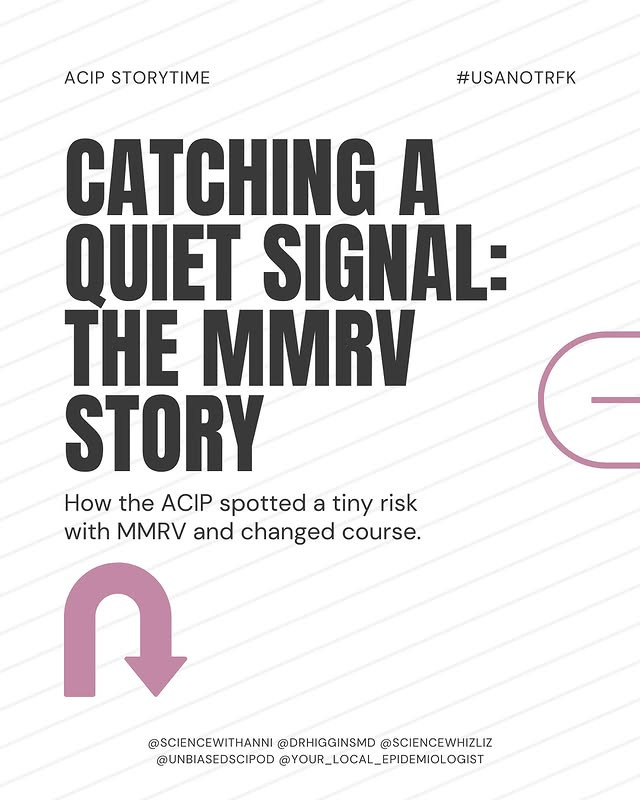They're About to Vote on Your Kids' Vaccines
Description
You remember that feeling in high school when you had a big test coming up and you prepared your head off, but still had a queasy feeling all week like you drank expired milk? That's the feeling we've had all week in anticipation of the upcoming ACIP meeting. Unfortunately, many of us are nervous because we fear we already know the outcome— like walking into an exam knowing the teacher has already decided to fail half the class. Pass the Pepto.
The Advisory Committee on Immunization Practices (ACIP) meets September 18-19, and based on the agenda, three vaccines are under scrutiny: MMRV (the combo measles-mumps-rubella-varicella shot), hepatitis B birth dose, and COVID-19 vaccines. Making matters more complex, Secretary Kennedy announced five new ACIP member appointments just today, bringing his total hand-picked appointments to 13 members since June (though one withdrew due to a conflict of interest). This rapid reshaping of the committee, which typically takes months or years, adds another layer of uncertainty. We don’t know a whole lot about the dozen folks who will literally be critical to determining our access (and our kids’ access) to these lifesaving vaccines.
For the full technical analysis with all citations, check out the briefing that several of us contributed to over at The Evidence Collective. But if you mainly want the nuts and bolts, let’s discuss…
The MMRV Vaccine and Febrile Seizures
Febrile seizures are seizures that can happen naturally when young children get fevers, and they can be scary to witness. They don't cause long-term problems, and kids are typically fine afterward, but that doesn't make them less frightening in the moment.
Very rarely, febrile seizures can occur after the first MMR dose (MMR is the vaccine that protects against measles, mumps, and rubella.). The ACIP committee may reconsider MMRV recommendations based on the risk of febrile seizures, potentially claiming this information was previously "concealed." This is puzzling because we've openly discussed this risk since 2009. About 1 in 3,000 children may have a febrile seizure after their first MMR vaccine. With MMRV, it's slightly higher—about 1 additional seizure per 2,300-2,600 children. Parents receive this information on the official vaccine information sheet, and the CDC already recommends giving MMR and the varicella vaccines separately for the first dose unless families prefer the combo. This lowers the risk of febrile seizures compared to MMRV. Again, these don’t cause long-term problems.
What often gets lost in this discussion is that by age 4-6, when kids get their second dose, there's no increased risk because most children have outgrown febrile seizures. So, families may choose MMRV at this age because, honestly, who wants to put their kid through two shots when one will do?
If the ACIP committee decides to restrict MMRV, we're looking at potential vaccine shortages during the worst measles outbreak in decades for babies at risk of complications from measles. We're also taking away parents' choice—ironically, at a time when medical freedom is supposedly valued. More shots mean more tears, more time off work, and historically, more kids who don't complete their vaccine series. This puts both kids and the broader health of the public at risk.
Hepatitis B Vaccine at Birth
We understand why parents question this one. Your baby was just born, perfect and healthy, and suddenly they're talking about a vaccine for something transmitted through blood and bodily fluids. "My baby isn't shooting up drugs or having sex," you might think. It's a fair point that deserves a real answer, not a dismissive one.
As we write this, NPR is reporting that ACIP is expected to vote on delaying the hepatitis B vaccine until age 4. Currently, it’s recommended to start at birth and complete the 3-dose series by 18 months. This would be a dramatic departure from 30+ years of successful policy. Yes, the most common transmission routes in adults are IV drug use and sex—but that's not how kids get infected. Infants commonly get infected during childbirth, when a mother’s blood can pass to the baby. Without preventive medical treatment (which includes the vaccine right after birth), 70-90% of babies born to infected mothers will get infected themselves. And 90% of babies infected through childbirth will develop a chronic, lifelong, and often debilitating form of Hepatitis B. Children get hepatitis B through other routes, including contact with infected household members who may be unaware of their infection, from bites at daycare that break the skin, or from sharing personal items like toothbrushes. The virus can survive for a week on surfaces, meaning children can be exposed in ways we don’t expect. Waiting until age 4 means four years of vulnerability during the time when infection is most likely to become chronic and cause lifelong liver damage.
As part of an ongoing series through our non-profit, The Center for Unbiased Science and Health, we're having conversations with folks who have changed their perspective on vaccines over time, and we want to share their stories.
Yesterday, we shared the story of one mom who was convinced that giving her baby the HepB vaccine was unnecessary because they weren't "high-risk", so when her baby was born she refused the HepB shot. Two weeks later, her son's father became violently ill. Turns out he'd been carrying the hepatitis B virus his entire life. He was born with it and never knew. The mom had to get tested and discovered she had also been infected at some point without knowing it. They were both infected but had no symptoms. Her baby had been exposed from day one, and suddenly she realized how close he'd come to disaster.
Fortunately, the mom changed her mind and started the vaccine series shortly after her son was born—protecting him from what could have been a lifetime of liver disease.
When babies get infected at birth, 90% go on to develop chronic infection that silently damages their liver for years, potentially leading to cirrhosis, liver cancer, or even death. Before we started vaccinating, 18,000 U.S. kids got hepatitis B annually by age 10, and half had no idea how they got it. The virus can survive on surfaces for a week and spread through invisible amounts of blood, not just from<a href="https://www.sciencedirect.com/science/article/abs







